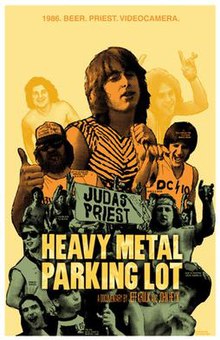|
Heavy Metal Parking Lot
Heavy Metal Parking Lot is a 1986 documentary short produced by Jeff Krulik and John Heyn. The film features interviews with several small groups of young heavy metal fans gathered for a tailgate party in the parking lot outside the Capital Centre in Landover, Maryland on May 31, 1986, as they prepare for a Judas Priest/Dokken concert being held there later that evening. ReputationBy the early 1990s, Heavy Metal Parking Lot had become an underground cult-classic, usually traded on bootleg VHS videotapes. It was reportedly a favorite on the Nirvana tour bus, among many other bands. Due to growing popularity of the film, music copyright issues arose between the producers and Judas Priest, though they were eventually resolved.[1] The film has been referred to as the "Citizen Kane of Wasted Teenage Metal."[2] SequelsKrulik and Heyn attempted to follow up Heavy Metal Parking Lot with Monster Truck Parking Lot in 1988, which showed fans of a monster truck rally, but the film was unfinished and unreleased. They then created Neil Diamond Parking Lot (1996) which showed fans before a Neil Diamond concert at the same Capital Centre parking lot, ten years after the original.[3] In 1999, they created Harry Potter Parking Lot.[4] Krulik and Heyn created and co-produced the 2004 TV series Parking Lot in association with Radical Media, which was broadcast on Trio. The series showed enthusiasts of various bands (like Phish) and activities (like surfing). Eight episodes were produced. In 2006, a sequel of sorts was released by SnagFilms, entitled Heavy Metal Parking Lot Alumni: Where Are They Now. The 19-minute film looks at the adult lives of several of the young people featured in the original 1986 film.[5] Home mediaIn May 2006, the documentary was released on DVD, to coincide with the 20th anniversary of its filming. The DVD version contains the original 17-minute film, as well as over 2 hours of exclusive content, including an interview with the infamous "Zebra-man" (a 22-year-old at the time), whom Krulik and Heyn tracked down and interviewed in the summer of 1999, 13 years after the original filming.[4] Cultural references
See alsoReferences
External links |
||||||||||||||
